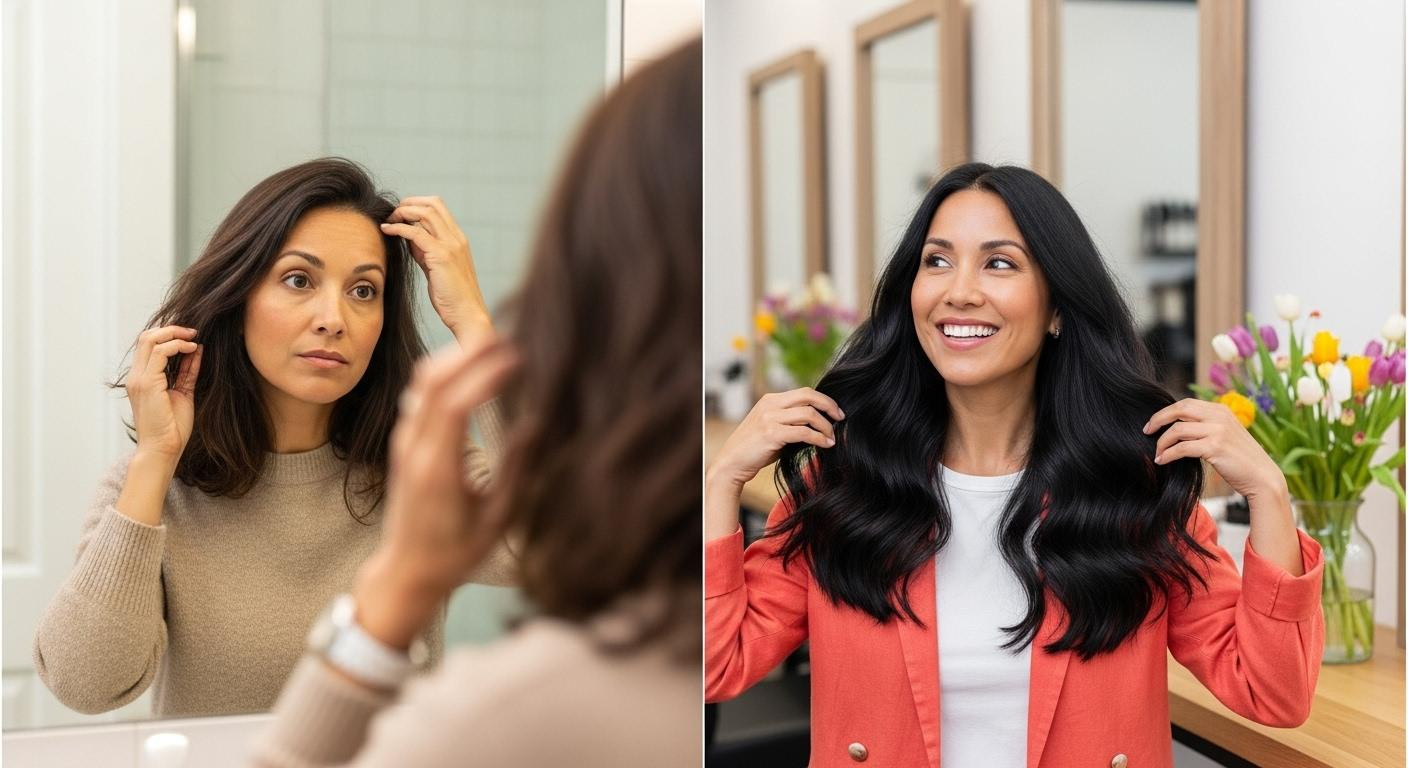Standing at the bathroom sink, box of permanent dye in hand, you notice something troubling. Your hair feels thinner than last month’s coloring session. You’ve been covering gray every four weeks for two years now. Hair breaks more easily, grays reappear faster, and your colorist suggests shorter intervals. You’re trapped in an invisible cycle that 73% of gray-covering women don’t recognize until significant damage accumulates. Dermatologists and trichologists confirm permanent dye dependency creates a self-perpetuating damage loop that intensifies with each application.
The 3-stage damage cycle traditional gray coverage creates
Every permanent dye application triggers a predictable sequence of structural deterioration. Chemical processes break down disulfide bonds that give hair its strength. Microscopic analysis reveals severely disrupted cuticle patterns after repeated exposure.
Stage 1: Cuticle disruption (weeks 1-4)
Ammonia or high-concentration peroxide forces cuticles open for pigment penetration. Hair feels manageable initially but structural integrity weakens invisibly. Trichologists document bubble-like formations within the cortex under microscopic examination.
Stage 2: Accelerated fragility (months 2-6)
Damaged cuticles create irregular porosity where some areas absorb too much moisture while others repel it. Women increase coloring frequency from six weeks to four weeks, compounding damage. Permanent hair dyes increase breast cancer risk by 9% for regular users according to recent research.
Stage 3: Dependency lock-in (month 6+)
Visible breakage forces shorter styles or corrective treatments. Hair becomes too fragile for harsh formulas yet the cycle feels inescapable. Professional colorists report that clients in this stage experience anxiety about gray visibility, perpetuating rushed recoloring decisions.
Why ammonia-free demi-permanent dyes break the pattern
Modern formulations using ethanolamine instead of ammonia open cuticles gradually with significantly less structural damage. These alternatives work through entirely different chemical mechanisms that preserve hair integrity.
The gentler cuticle opening mechanism
Demi-permanent formulas use 10-volume developer maximum versus the 20-40 volume used in permanent dyes. This lower oxidative stress deposits color without lifting natural pigment. Cosmetic chemists with expertise in active ingredients confirm substantially less protein denaturing per application.
The 6-8 week longevity advantage
Semi-permanent lasts 4-6 weeks while demi-permanent extends to 6-8 weeks with gradual fade. No harsh regrowth line appears. This extends coloring intervals from four weeks to eight weeks, cutting annual applications from 13 to 6-7 sessions while maintaining coverage.
The exact products and techniques that work after 50
Professional analysis of at-home options reveals specific formulations that minimize damage while delivering satisfactory gray coverage. Room-temperature processing reduces heat-accelerated damage by 30% according to recent studies.
At-home ammonia-free options ($10-$25)
Madison Reed Radiant Cream Color at $25 contains hydrating ingredients with over 100 shades. Clairol Natural Instincts at $10 offers semi-permanent coverage with aloe and coconut oil. Garnier Nutrisse provides nourishing cream formulas with drugstore accessibility.
Salon melting technique (3-4 month intervals)
Professional melting blends multiple tones from roots to ends, creating dimensional gray integration versus solid coverage. This technique requires touch-ups every 3-4 months only, compared to monthly permanent applications. Cost ranges $60-$120 but frequency reduction makes annual expenses comparable with dramatically less damage.
The counter-intuitive safety truth about modern hair dyes
Modern formulations removed coal-tar derivatives and reduced harmful chemical concentrations significantly. Yet Consumer Reports reveals that application frequency determines long-term risk more than formula alone. Permanent dye every four weeks for two years equals 26 chemical exposures. Demi-permanent every eight weeks reduces this to 13 exposures with half the cuticle damage per application. Documented cases show hair lead levels reaching 710 (normal is less than 0.8) from frequent dyeing. Patch testing 48 hours before application reduces allergic reactions by 80%, yet most at-home users skip this critical step.
Your questions about refreshing gray hair at 50 with gentle coloring answered
Can ammonia-free dyes really cover stubborn grays as effectively as permanent formulas?
Demi-permanent formulas provide 85-90% gray coverage versus 95-100% from permanent options with proper application technique. Research from the American Academy of Dermatology shows this 5-10% coverage trade-off prevents the damage cycle that makes hair more gray-prone over time.
How do professionals approach gray coverage differently than typical at-home methods?
Salon techniques emphasize dimensional blending rather than complete gray erasure. The melting approach creates natural-looking highlights while reducing maintenance frequency. Professional sectioning in 0.25-inch parts ensures even coverage without over-processing.
What’s the single biggest mistake women make when choosing gray coverage at 50?
Prioritizing immediate full coverage over long-term hair health creates the invisible damage cycle. Dermatologists specializing in natural anti-aging recommend starting with demi-permanent for three months. If hair condition improves while maintaining coverage, the destructive cycle breaks permanently.
Three months from now, fingers run through hair that feels thicker, not thinner. Eight weeks stretch between colorings instead of four. Gray roots fade naturally into dimensional tones rather than harsh demarcation lines. The bathroom mirror reflects genuinely healthier hair because you escaped the cycle.
